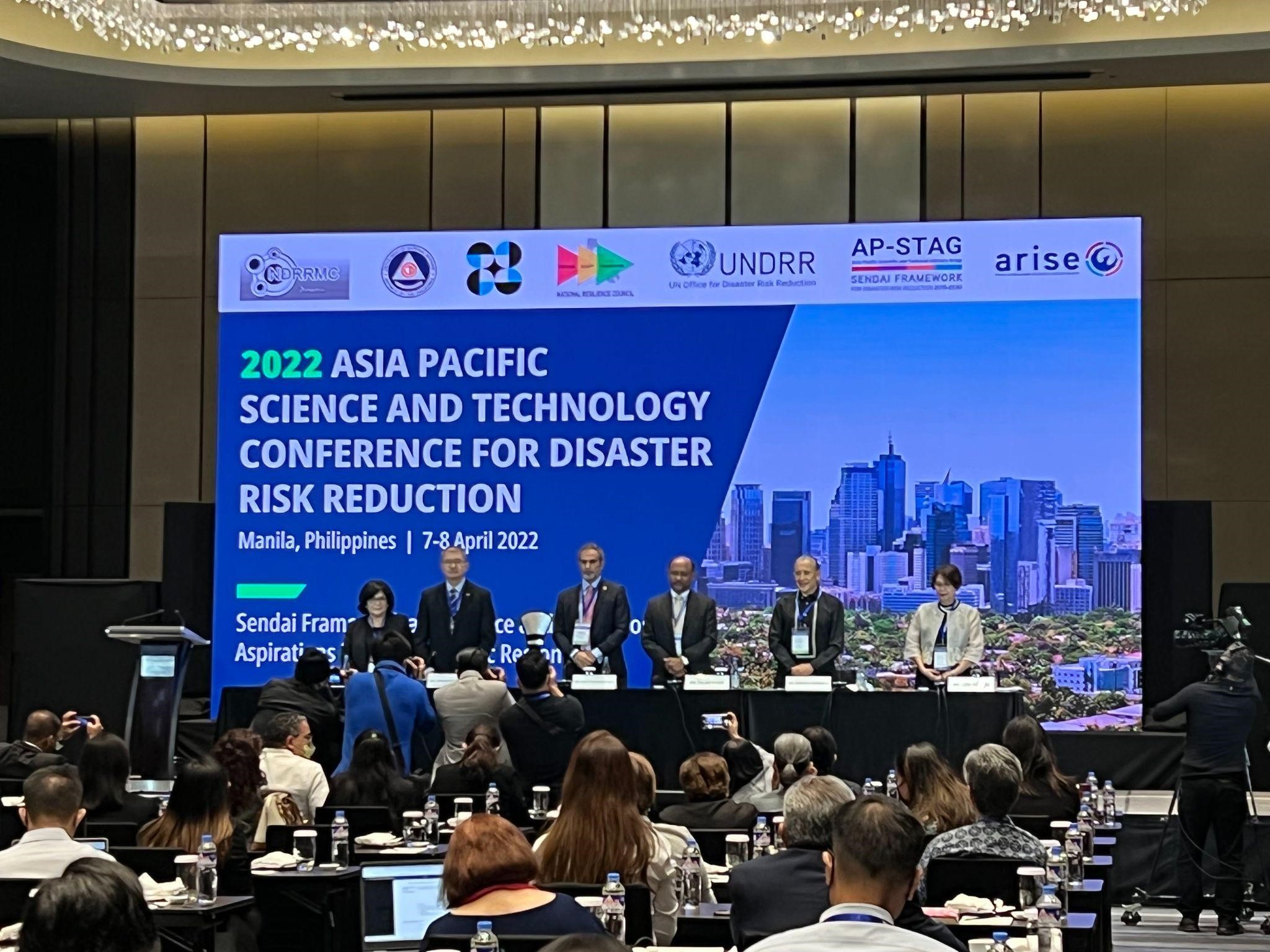AsPac experts, government leaders promote application of science, technology, and innovation in disaster risk reduction and management

The 2022 APSTCDRR was held in a hybrid format on 7-8 April 2022 in Manila, Philippines
Gathering more than 1,000 virtual participants and 150 physical attendees around the world, the 2022 Asia Pacific Science and Technology Conference for Disaster Risk Reduction (APSTCDRR) was held in a hybrid format on 7-8 April 2022 in Manila, Philippines.
The 2022 APSTCDRR was the first blended international conference on science and technology for DRR in Asia Pacific that also included both private and public sector from local and the international community, in the organizing committee. It is held biennially and was hosted by Thailand in 2016, China in 2018, and Malaysia in 2020.
The speakers at the opening ceremony of the 2022 APSTCDRR.
(From L-R NRC President and APSTAG Member Ms. Antonia Loyzaga-Yulo, DOST Secretary Fortunato T. de la Peña, UNDRR-ROAP Chief and APSTAG Co-Chair Mr. Marco Toscano-Rivalta, Keio University Professor and APSTAG Co-Chair Dr. Rajib Shaw, UN Resident Coordinator and Humanitarian Coordinator in the Philippines Mr. Gustavo Gonzalez, and SM Supermalls Vice President for Corporate Compliance and ARISE Global Board Member Ms. Liza Silerio)
The Department of Science and Technology (DOST) is one of the co-organizers of the Conference, together with the National Resilience Council (NRC, Chair of the Organizing Committee), National Disaster Risk Reduction and Management Council (NDRRMC), Office of Civil Defense (OCD), United Nations Office for Disaster Risk Reduction Regional Office for Asia and the Pacific (UNDRR-ROAP), UNDRR Asia Pacific Science and Technology Advisory Group (APSTAG), and ARISE Philippines.
DOST officials shared their messages in the Conference
“From Victims of disasters to Victors” is how the DOST envisions to rebrand Filipino resilience, according to DOST Secretary Fortunato T. de la Peña in his opening remarks. The DOST chief illustrated how science can be applied in building programs for disaster risk reduction and management (DRRM) through enumerating the milestones of the DOST in the sector. The list includes the development of the country’s own satellites and using their data in mapping hazards and assessing environmental conditions on the ground. The list continues to showcase the digital platform that identifies hazards and risks in different geographical locations, structural health monitoring system for buildings and bridges, the software that simulates earthquake hazards, the advances in early warning system, and innovative and nutritious disaster relief goods.
DOST Secretary Fortunato T. de la Peña delivers his opening remarks at the 2022 APSTCDRR.
Secretary de la Peña stressed that S&T innovations and services address the full cycle of prevention, mitigation, preparedness, response, and recovery. The DOST Secretary concluded his remarks by calling on all key players to rally more closely on constantly innovating in DRR as science, technology, and innovation (STI) shape the future.
DOST Undersecretary Renato U. Solidum Jr. also took the floor on the second day of the Conference. The DOST Undersecretary for Scientific and Technical Services raised that science needs to work with interconnected systems, sectors, and disciplines. Science works effectively in decision making. According to Undersecretary Solidum, science, technology, and innovation is a powerful tool in facing the consequences of disasters. Policies need to be inclusive and science-based.
Usec. Renato U. Solidum Jr. being introduced with NDRRMC Executive Director Usec. Ricardo Jalad at the opening ceremony of the 2022 APSTCDRR Day 2.
Conference Sessions discuss the application of STI in DRR and policies
The Conference highlighted opportunities to advance the applications of science, technology, and innovation (STI) in disaster risk reduction (DRR) and climate change adaptation from the local to regional to global sphere. It underscored that the current pandemic has exacerbated the vulnerability of lives, livelihoods, and the environment.
The Conference was divided into eight (8) technical sessions where key experts discussed (i) the incorporation of STI in policy and practice, (ii) the successes and insights gained from applying STI in relation to the Sendai Framework for DRR 2015-2030, (iii) the localization and inclusiveness of STI application in DRR, (iv) the importance of investing in disaster-resilient infrastructure, (v) the need for support from the private sector; and (vi) the significance of cascading compound and systemic risks to protect lives.
Usec. Solidum, along with other speakers in Technical Session 2 joining virtually, at the Q&A segment.
An Innovation Pitch of U-Inspire and UNESCO was also conducted during the Conference. It emphasized that the youth and young professionals (YYPs) are catalysts for innovations in science, engineering, technology, and innovation (SETI) and in DRR. The Pitch featured several initiatives from the YYPs in the region by utilizing SETI to engage with local communities and various stakeholders.
At the end of the two-day conference, Antonia Yulo-Loyzaga presented the Manila Declaration on Science and Technology for Disaster Risk Reduction. The outcomes and policy recommendations of the conference will serve as a contribution to the Asia Pacific Ministerial Conference on Disaster Risk Reduction on 19-22 September 2022 in Brisbane, Australia and to the Midterm Review of the Sendai Framework which will take place in
2023 following a decision by the UN General Assembly. (30) (By Karen Lou Mabagos and Paolo Samoza, DOST-ITCU)

